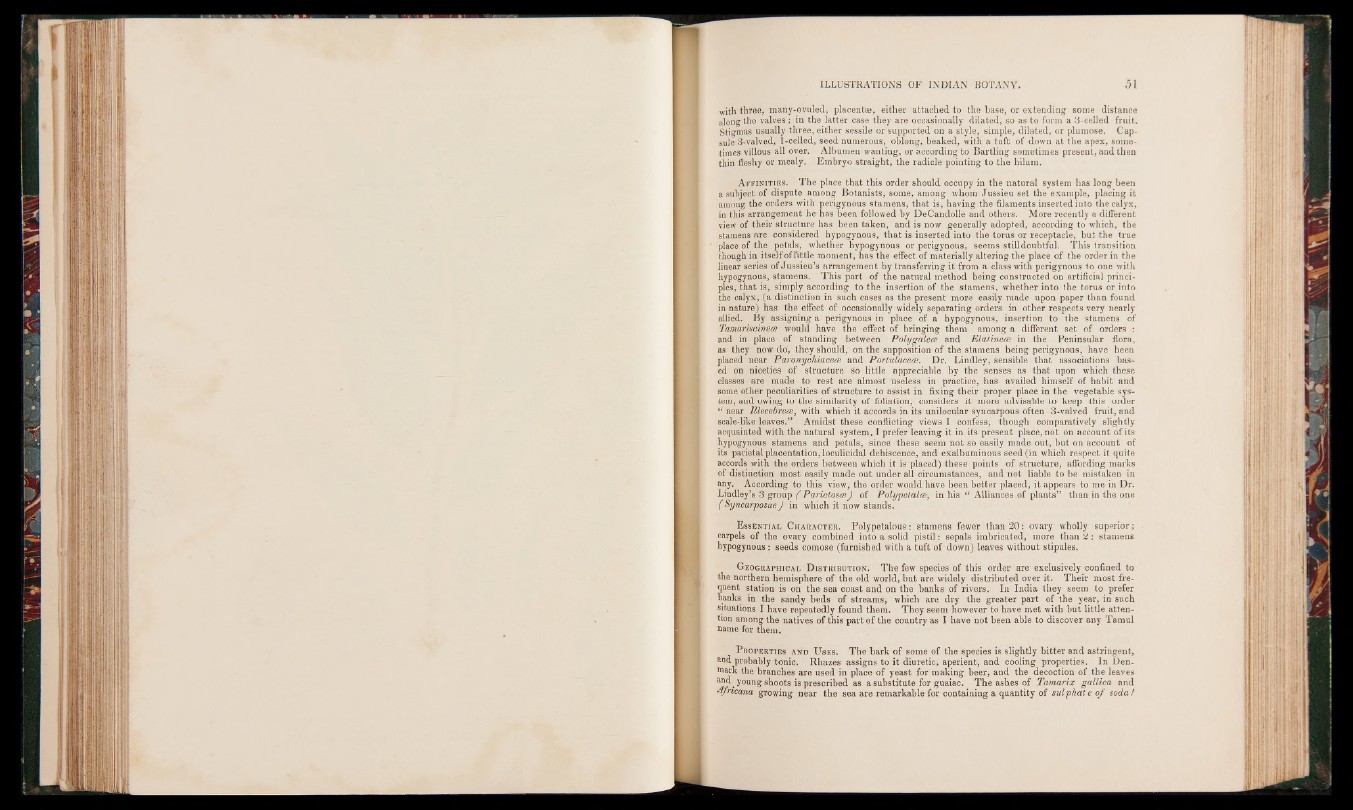
with three, many-ovuled, placentae, either attached to the base, or extending some distance
along the valves; in the latter case they are occasionally dilated, so as to form a 3-celled fruit.
Stigmas usually three, either sessile or supported on a style, simple, dilated, or plumose. Capsule
3-valved, 1-celled, seed numerous, oblong, beaked, with a tuft of down at the apex, sometimes
villous all over. Albumen wanting, or according to Bartling sometimes present, and then
thin fleshy or mealy. Embryo straight, the radicle pointing to the hilum.
A ffinities. The place that this order should occupy in the natural system has long been
a subject of dispute among Botanists, some, among whom Jussieu set the example, placing it
among the orders with perigynous stamens, that is, having the filaments inserted into the calyx,
in this arrangement he has been followed by DeCandolle and others. More recently a different
view of their structure has been taken, and is now generally adopted, according to which, the
stamens are considered hypogynous, that is inserted into the torus or receptacle, but the true
place of the petals, whether hypogynous or perigynous, seems still doubtful. This transition
though in itself of little moment, has the effect of materially altering the place of the order in the
linear series of Jussieu’s arrangement by transferring it from a class with perigynous to one with
hypogynous, stamens. This part of the natural method being constructed on artificial principles,
that is, simply according to the insertion of the stamens, whether into the torus or into
the calyx, (a distinction in such cases as the present more easily made upon paper than found
in nature) has the effect of occasionally widely separating orders in other respects very nearly
allied. By assigning a perigynous in place of a hypogynous, insertion to the stamens of
Tamariscinece would have the effect of bringing them among a different set of orders :
and in place of standing between Polygalece and Elatinece in the Peninsular flora,
as they now do, they should, on the supposition of the stamens being perigynous, have been
placed near Paronychiacece and Portulacece. Dr. Lindley, sensible that associations based
on niceties of structure so little appreciable by the senses as that upon which these
classes are made to rest are almost useless in practice, has availed himself of habit and
some other peculiarities of structure to assist in fixing their proper place in the vegetable system,
and owing to the similarity of foliation, considers it more advisable to keep this order
‘f near lllecebrece, with which it accords in its unilocular syncarpous often 3-valved fruit, and
scale-like leaves.” Amidst these conflicting views I confess, though comparatively slightly
acquainted with the natural system, I prefer leaving it in its present place, not on account of its
hypogynous stamens and petals, since these seem not so easily made out, but on account of
its parietal placentation, loculicidal dehiscence, and exalbuminous seed (in which respect it quite
accords with the orders between which it is placed) these points of structure, affording marks
of distinction most easily made out under all circumstances, and not liable to be mistaken in
any. According to this view, the order would have been better placed, it appears to me in Dr.
Lindley’s 3 group ( Parietosce) of Polypetalce, in his “ Alliances of plants” than in the one
( Syncarposae) in which it now stands.
E ssential C haracter. Polypetalous: stamens fewer than 20: ovary wholly superior;
carpels of the ovary combined into a solid pistil: sepals imbricated, more than 2 : stamens
hypogynous : seeds comose (furnished with a tuft of down) leaves without stipules.
G eographical D istribution. The few species of this order are exclusively confined to
the northern hemisphere of the old world, but are widely distributed over it. Their most frequent
station is on the sea coast and on the banks of rivers, In India they seem to prefer
banks in the sandy beds of streams, which are dry the greater part of the year, in such
situations I have repeatedly found them. They seem however to have met with but little attention
among the natives of this part of the country as I have not been able to discover any Tamul
name for them.
P roperties and U ses. The bark of some of the species is slightly bitter and astringent,
and probably tonic. Rhazes assigns to it diuretic, aperient, and cooling properties. In Denmark
the branches are used in place of yeast for making beer, and the decoction of the leaves
. young shoots is prescribed as a substitute for guaiac. The ashes of Tamarix gallica and
•flfhcana growing near the sea are remarkable for containing a quantity of sulphate o f soda!